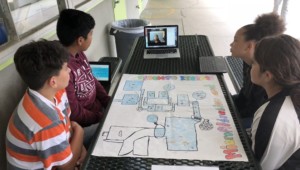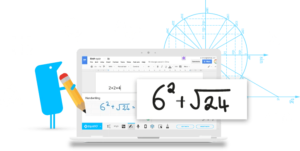10 EdTech Tools for Encouraging Classroom Collaboration

By Rachelle Dene Poth
Today’s technology offers so many options for educators and students that deciding on where to begin can be overwhelming. To get started, think about one new approach that could be the catalyst for positive change in your classroom. In looking at your learning environment, what could benefit your students the most? One area that I immediately thought I could improve upon was classroom collaboration.
How do you find tools to help meet these needs? Resources are everywhere: books, blogs, social media like Twitter chats, Voxer groups, your PLN, or even conferences, EdCamps and similar professional development opportunities. But even with all of these resources available, it still comes down to taking a risk and trying something new.
Here are some helpful and versatile technology tools to easily and quickly integrate into your classroom and get your students in a classroom collaboration mindset.
Discussion Tools: Get Them Talking
Teachers need to hear from students, and we know that asking questions or calling on students to discuss a topic can often make them nervous. When students, or anyone, develop that feeling of “being on the spot”, it can become more difficult to encourage students to share what they are thinking, what they are feeling and what their true opinions are. This is where digital tools can provide security and opportunities for students to express themselves. Technology has a true purpose. Students still need to develop the ability–and confidence–to speak in class, but these tools can help by providing a comfortable way for students to develop their voice and express themselves.
Depending on the type of question or discussion format you want your classroom collaboration to focus on, there are many tools available that can help.
1. SurveyMonkey is a good way to ask a variety of questions, find out what students are thinking, use it for a quick formative assessment, and many other possibilities. I have used it to find out how students prepared for tests, what areas they need help with, and even for voting for club officers and planning trips. You have the results quickly and can provide feedback instantly, to plan your next steps in class. It can be a different way to find out about your students and their needs.
2. TodaysMeet is a backchannel tool that can be used in or out of class, as a way for students to contribute to a discussion or ask questions. It can also be used to provide “office hours” online, for students to ask questions beyond the school day. There are many possible uses for this tool, and setting it up is easy.
3. GoSoapBox is a response tool that can be used to ask a variety of questions without students having to create accounts. Students simply need an “event code” provided by the teacher to access the activities available. GoSoapBox can be used for polls, discussion questions, quizzes and more, and provides a fast way to assess students or to simply learn more about them and their thoughts.
4. Recap is a video response tool, where students can respond to a prompt and all responses are compiled into a “daily reel” for teachers to view and provide feedback. Students can respond from anywhere and feel comfortable in sharing their thoughts using this tool.
These are just four of the many options—sometimes it just takes a bit of research. Asking the students for new ways to use the tools you have already been using in class can also be helpful.
Communication Through Collaboration
There are many options which promote classroom collaboration and enhance writing skills and student voice.
5) Blogging: Through blogging, teachers can provide support for students and help them to gain confidence in writing and speaking. We have used Kidblog to complete many writing tasks and creative writing assignments.
6) Wikispaces: A Wiki has worked really well in our classes for having students collaborate on a topic, create a discussion page, and set it up to inform on a topic, to list just a few examples. We created a wiki on Spanish art and also created our own travel agency.
7) Padlet: Padlet is a “virtual wall” which promotes collaboration, communication, creativity and more because of its versatility. Students can write a response to a discussion question, add resources for a collaborative class project, work in small groups, use it for brainstorming or connect with other students and classrooms throughout the world.
Using digital tools in this way is great because the discussions don’t have to end when class does. These tools provide ways to get students talking and share their ideas, so that classroom collaboration can even be taken home.
Creating presentations and telling a story
A few options for having students present information in a visual way with options for multimedia include the following:
8) Buncee is a web based tool that can be used for creating presentations, interactive lessons and more, with many options for including different characters, fonts, animations, video and more.
9) Piktochart is a tool for creating infographics, social media flyers, engaging presentations and more. Students have created menus, self-descriptions, movie and tv advertisements, recipe presentations and much more.
10) Visme is a “drag and drop” tool that is easy to use for creating infographics, reports, different presentations and more. It has a library full of images, charts and more, making it easy for users to create exactly what they need.
What are the benefits of these tools?
Each of these tools promote more personalized and meaningful learning for students, along with a healthy dose of classroom collaboration. These tools can be used to enhance, amplify and facilitate deeper and more authentic learning. Using technology just for the sake of using it doesn’t make sense. But using it to help students find their voice, learn what they want to do, what they can do and what they need help with, does make sense.
For more, see:
- Teaching Collaboration Through Preparation and Project-Based Learning
- How to Create a New Culture of Learning
- Teaching Students Collaboration Through the Five Dysfunctions of a Team
Rachelle Dene Poth is a Foreign Language and STEAM Teacher at Riverview Junior Senior High in Oakmont, PA. Follow her on Twitter at @rdene915.
Stay in-the-know with all things EdTech and innovations in learning by signing up to receive the weekly Smart Update.







Pierre Sutherland
My dissertation study focuses on increased classroom interaction, especially around discussion, and the beta version is freely available at www.teachersarevaluable.org
Nandini
I'd add ProofHub in this list for collaboration. It is project management and collaboration tool to manage your projects and team. ProofHub simplifies task management and team handling and thereby eliminates the need of relying on emails to manage and collaborate, making it a really must have tool for every team. Take a look at www.proofhub.com
Janett_Harmon
You may consider one widely used tool, R-HUB TurboMeeting for interactive collaboration using HD video and web conferencing. It supports unlimited users with on-premises security.
sophia
Nice list of tools.
There is also another tool i.e Factile which helps you to encourage classroom collaboration. "Factile is fun and exciting. Students enjoy the competition, the team-building, the camaradarie, the positive reinforcement.
Sam Rumney
Great list of tools. Also, I would like to add a tool to this list which is http://clariti.app/ . This is one of the best online Collaboration tools That I have come across in recent days.